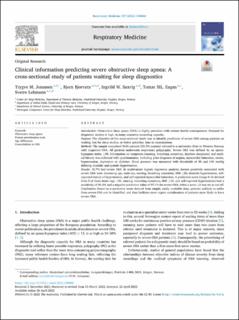Clinical information predicting severe obstructive sleep apnea: A cross-sectional study of patients waiting for sleep diagnostics
Jonassen, Trygve Müller; Bjorvatn, Bjørn; Saxvig, Ingvild W.; Eagan, Tomas Mikal Lind; Lehmann, Sverre
Journal article, Peer reviewed
Published version

Åpne
Permanent lenke
https://hdl.handle.net/11250/3039942Utgivelsesdato
2022Metadata
Vis full innførselSamlinger
Sammendrag
Introduction
Obstructive sleep apnea (OSA) is highly prevalent with serious health consequences. Demand for diagnostic studies is high, in many countries exceeding capacity.
Purpose
The objective of this cross-sectional study was to identify predictors of severe OSA among patients on waiting lists for sleep studies, to better prioritize time to examinations.
Methods
The sample comprised 3646 patients (30.3% women) referred to a university clinic in Western Norway with suspected OSA. All patients underwent respiratory polygraphy. Severe OSA was defined by an apnea-hypopnea index ≥30. Information on symptoms (snoring, breathing cessations, daytime sleepiness) and medical history was collected with questionnaires, including prior diagnosis of angina, myocardial infarction, stroke, hypertension, depression or diabetes. Blood pressure was measured with thresholds of 90 and 140 mmHg defining diastolic and systolic hypertension.
Results
15.7% had severe OSA. In multivariate logistic regression analysis, factors positively associated with severe OSA were increasing age, male sex, snoring, breathing cessations, BMI ≥30, diastolic hypertension, self-reported history of hypertension, and self-reported myocardial infarction. A prediction score (range 0–5) devised from 5 of these items (age ≥50, snoring, breathing cessations, BMI ≥30, and self-reported hypertension) had a sensitivity of 96.2% and a negative predictive value of 97.1% for severe OSA, when a score ≥2 was set as cut-off.
Conclusions
Based on a prediction score derived from simple, easily available data, patients unlikely to suffer from severe OSA can be identified, and thus facilitate more urgent consideration of patients more likely to have severe OSA.
